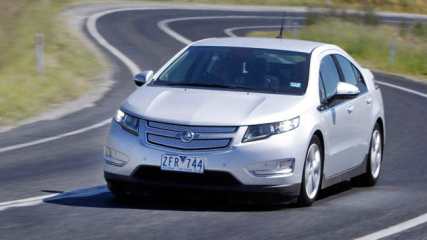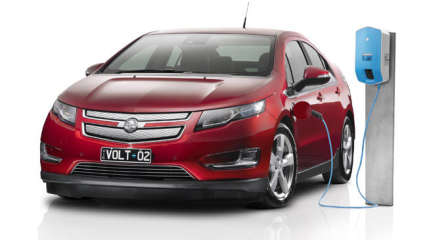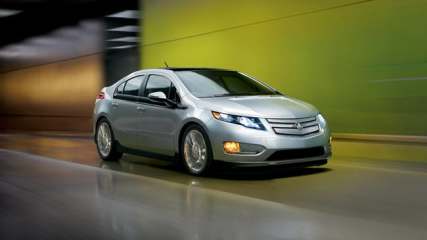Holden Volt 2014 News

Electric car sales still a trickle in Australia
Read the article
By Chris Riley · 22 May 2015
The electric dream is fast turning into a nightmare - Australian sales of electric vehicles have dwindled to a trickle.
.jpg)
Holden Volt set to be recalled
Read the article
By Joshua Dowling · 13 Mar 2015
In the US, more than 64,000 Chevrolet Volt electric cars are being recalled, which is expected to prompt a recall of more than 200 Holden versions next week.

Petrol vs electric cars | an update
Read the article
By Paul Gover · 17 Nov 2014
Can the new BMW i3 change the way Australians embrace electric cars?The increase in fuel tax has sparked predictable radio chatter this week about the cost of motoring. Apart from ordinary families facing another belt in the budget, experts from all points of the compass talked about the future of fossil fuel and the hybrid and plug-in electric cars already on the road.One spoke of fuel cell cars that generate on-board electricity (but not of the hydrogen stations needed to keep them going).The reality is that electric cars, despite big talk by everyone up to global head of Nissan-Renault Carlos Ghosn, are struggling for traction across the world.So far this year, only 200 Australians have bought a battery car. We don't know how many are with ordinary motorists or government departments and councils.The big problems for battery cars are obvious: cost and 'range anxiety'. The price problem will never go away until governments are prepared to provide the sort of subsidies that have boosted sales in Europe and the US going back to the original Toyota Prius. The Australian list price for a Leaf is $39,990 - it's similar in size to the Pulsar you can buy for less than $20,000. The Holden Volt is $59,990.Range anxiety is the fear of running short of charge, even though Australians typically commute less than 100km daily.Both challenges came into sharp relief this week as I slid into the latest electric contender, the BMW i3. It's a brilliant car, despite four safety stars, trendy, efficient and drives well.BMW has an optional range-extender engine that lifts the distance between charges to 300km but there is still the problem of price - are people prepared to pay at least $63,900 for a future car that's here and now?

Plug-in a turn-off
Read the article
By Paul Gover · 24 Sep 2013
But do we really care more about volts and hertz than kiloWatts and Newton-metres?

Electric car breakthrough will come from China Ghosn
Read the article
By Paul Gover · 13 Mar 2013
China is set to provide the power for the large-scale introduction of electric cars as it accelerates towards two million sales a year by 2020.
Australians have bought a relative handful of plug-in cars since the start of local sales, despite the quality of the Nissan Leaf and Holden Volt, as government at all levels ignores calls for the sort of subsidies and tax breaks that have provided a vital spark in Europe and the USA.
Renault Australia was forced to pull the plug on its Fluence ZE, a battery-swap electric car, because of the lack of infrastructure and problems for its energy partner, Better Place.
But China could change the game as it forces carmakers to adopt electric and plug-in hybrid technology to cut its reliance on imported oil and reduce pollution in the overcrowded cities where more than half of its population is concentrated.
"I think the breakthrough will come from China. I think the solution is going to be there," says Carlos Ghosn, the head of Renault-Nissan. "China is moving very aggressively. All the problems are lining up to make China the biggest electric car and plug-hybrid market in the world."
His company is leading the world in production of electric cars, including the Nissan Leaf and impressive new Renault Zoe, although he admits sales have been slow with just 70,000 deliveries worldwide over the past five years.
"Four or five year ago, when we decided to go with electric cars, people were considering electric cars like a golf cart. But we came with the leaf and now the Zoe, which is a very good car. The 70,000 people today who are driving electric cars are very happy with the product," Ghosn says.
But he also recognises the challenges. "The main obstacles to electric cars are mainly linked to infrastructure and range, because they are connected. If you can do only 100 or 150 kilometres, well, you worry about range. But if there is infrastructure everywhere you don't worry about the range. If you can charge at the mall or work."
He says the other barrier is cost, even though the Zoe will be the equivalent of $14,000 in Europe - plus a monthly battery rental - thanks to large-scale government subsidies. "People want environmentally friendly cars but they don't want to pay for them. They just want an even price," Ghosn says.
"The solution is going to be there. We must continue to reduce the price of the car, through continuous improvement, and continue to lobby and work with cities and governments in order to have the infrastructure." But he says the big push is coming from China, where carmakers are being forced into electric-car partnerships.
"The Chinese have already taken very hard decisions and they have said two million electric cars in 2020. You cannot have any investment decision agreed by the government in China if you do not have what they call a 'new-energy' car.
A 'new energy' car is an electric car or a plug-in hybrid. If you don't have them don't ask to increase capacity, even of normal gasoline cars." But Ghosn says China is not the only country accelerating its electric drive.
"On top of this, France is moving aggressively, the US is moving aggressively and some cities are moving aggressively," he says. "The mayor of London has told us already he would like to have all the taxis in London as zero emission. We are negotiating with the mayor of Rio in preparation for the Olympics.
"We have seen a lot of initiative coming. We need to be patient. We need to continue to develop the technology, develop the product, cut the costs and make the cars better. "When it takes off, we will be ready."
This reporter is on Twitter @paulwardgover

Electric cars told to make some noise
Read the article
By Joshua Dowling · 09 Jan 2013
Electric cars and hybrids are set to be required by law to make a humming noise when travelling at low speeds – to prevent deaths and injuries of elderly or vision impaired pedestrians in shopping centres and car parks.
In a landmark submission filed overnight the peak road safety authority in North America recommended external speakers become compulsory on all electric vehicles and hybrids from 2016.
Currently, the only sound from cars running on electric power is the almost-silent rolling of the tyres. Some cars, such as the Nissan Leaf electric car, already make a deliberate hi-tech hum below 30km/h – but the noise can be disabled by the driver at the press of a button on the dash.
Toyota began fitting outside speakers to the Prius hybrid in North America last year – but they’re yet to be fitted to models sold in Australia.
“It’s something we’re looking at seriously,” said Toyota Australia spokesman Mike Breen. “We’ve had some calls from various agencies who’ve expressed concern about cars being heard by people with limited sight. We are working with Toyota Japan to find what would best suit conditions in Australia.”
Toyota has sold more than 10,000 hybrid cars in Australia over the past 10 years but says it is yet to receive a report of someone being knocked over by one of its petrol-electric vehicles while in silent mode.
The Holden Volt plug-in hybrid car doesn’t have a hum – but it does have what the company calls a “polite” horn. If you tap the button, it gives a short toot at half the normal volume to let others know you’re nearby.
“If were mandated in North America, the technology would likely make its way onto cars here,” said Holden spokesman Craig Cheetham.
Vision Australia said electric cars were a danger to blind people and the visually impaired and has called for “urgent action”.
“It’s a significant safety problem,” said Vision Australia spokeswoman Megan Bishop. “Environmental sound is critically important for people who are blind or vision impaired.
“Sound is an essential aid to independent mobility and safety. People have a fundamental right to travel independently as pedestrians.”
In the US, Congress ordered an investigation into the dangers caused by silent electric cars three years ago. It is likely to become an increasing concern as the population ages.
The latest report by the National Highway Traffic Safety Administration (NHTSA) estimates external speakers would prevent 2800 injuries a year and add $30 to the cost of each electric car.
The safety body said it would allow car manufacturers the freedom to choose their own sounds.
“Our proposal would allow manufacturers the flexibility to design different sounds for different makes and models while still providing an opportunity for pedestrians, bicyclists and the visually impaired to detect and recognise a vehicle,” NHTSA Administrator David Strickland said in a statement.
In the US, the public will be given 60 days to comment on the proposed regulations, which will apply to electric cars, trucks, buses and motorcycles.
This reporter is on Twitter: @JoshuaDowling

Holden Volt
Read the article
By Neil Dowling · 11 Dec 2012
Too heavy, but good to drive. "For all the greenery, it's still got an internal combustion engine in it. And it should be forty grand," Chris Riley said at the COTY judging.

Holden Volt vs Commodore SV6 LPG vs Cruze CDX
Read the article
By Chris Riley · 30 Aug 2012
Holden's all new humming and dancing Volt electric car returns an amazing 1.2 litres per 100km juice use. Although equipped with a small petrol engine like a hybrid, the Volt is an electric car with a “range extender” because the petrol component never directly powers the wheels.
Rather it generates power to run the electric motor when the battery pack runs flat. And that mans, like any EV, it wants plugging in to recharge before it’s good to go again. Still, it’s an exciting concept from company associated with far more mundane modes of mobility.
But before we nominate it for the Eureka Prize for scientific innovation, it’s worth considering the immutable maths of the matter. Those less exotic Holdens, including the LPG-powered Commodore SV6 and turbo diesel Cruze CDX sedan, are both vastly cheaper to buy and – it transpires – to own.
Priced from $46,290, the SV6 returns 12.3 litres/100km. The $31,040 Cruze auto gets 6.7 litres/100km. Neither are in the Volt’s ballpark. And yet …
Checking the price of fuel today we found a Sydney spot that dished up LPG at 65.9 cents a litre, diesel for 144.9 cents and the Volt’s premium 95 unleaded for 145.9 cents. Why top notch juice? Because that's what Holden use to achieve the official fuel test figures you see on the windscreen sticker.
At these prices the Volt costs $1.75 to run for every 100km travelled, the Commodore $8.24 and the Cruze $9.71.
But – and it’s a big but – when you factor the Volt’s $14,000 premium over the Commodore and the $29,000 over the Cruze, it’s battery powered glow begins to fade.
The sums you save on either pays for a whole lot of fuel for a long time to come. You would have to travel 211,000km before breaking even with the Commodore or a whopping 363,000km in the case of the Cruze.
Does anyone other than taxi drivers keep their cars for such distances? And we all know what they feel like after that long on the road. They're just not built to go the distance.
You could “Cruze” all the way to the Moon or circumnavigate the Earth five times in the Commodore before the Volt would start paying for itself. If it’s not easy being green, it also sure ain’t cheap.

Holden Volt will sell under $60,000
Read the article
By Stuart Martin · 02 Jul 2012
The price slots the Volt in between the V6 and V8 Calais V Commodore sedan models. Holden staffers say the plug-in electric vehicle will arrive in the last quarter of the year and early-adopters can order now.
The Volt -- which has an electric-only range of nearly 90km but extended to 600km using the on-board engine -- will be in one model specification but also brings a forward collision alert and lane departure warning safety systems to the Holden stable for the first time.
Keyless entry and start, eight airbags, front and rear parking sensors, a reversing camera and touchscreen satellite navigation are also among the Volt's features. The infotainment system has a 30gb inbuilt hard drive linked to a six speaker BOSE that uses Bose Energy Efficiency Series speakers that require 50 per cent less energy to run.
Holden's sales and marketing executive director John Elsworth said Holden had chosen to launch the Volt in with a strong features list.
"Volt will offer some of the most advanced electric vehicle technologies in Australia and has won a long list of awards and fans around the globe,'' he said. Mr Elsworth said the Volt would prove electric cars don't need to be quirky and had what buyers expected from Holden.
"It will have real appeal to buyers looking to drive the latest in technology, without having to compromise on either range or functionality. "With all of the standard premium features, Volt makes a very compelling choice for car buyers who may not have considered an electric car before or may be looking at premium European vehicles,'' he said.
The company has also revealed a fixed-price servicing program for the Volt - $185 for the first four standard scheduled log book services for the first three years or 60,000km, whichever comes first. Holden also confirmed there would be a transferable eight year/160,000km warranty on the Volt battery, charging and electric drive components.

Holden Volt joins electric trial
Read the article
By Craig Duff · 07 Jun 2012
The cars have been enlisted to supply recharge data for the Victorian Government's Electric Vehicle Trial. Four Aussie-spec Volts will join four left-hand drive evaluation vehicles in a 12-week test of the vehicles' typical range and recharge patterns ahead of the car's local launch late this year.
Holden's director of Energy and Environment Richard Marshall says: "By getting involved in the Victorian Electric Vehicle Trial we hope to develop a better understanding of how people drive and recharge vehicles in Australia."
The eight cars will be driven by Holden staff, who will provide feedback to the launch team and share their experience of living with an electric car via social networks.
"Ordinarily the vehicle development process is shrouded in secrecy but with Volt we're taking a different approach and encouraging the evaluation drivers to talk about their cars with friends, families and online contacts," Marshall says.
The Volt is the size of a Holden Cruze but is powered by what GM says is the world's first extended range electric vehicle, meaning the 1.4-litre petrol engine is used to generate more electricity instead of helping with locomotion. Holden says the Volt has a range of up to 80km on electric power, with the petrol engine extending that to 600km.
More than 60 vehicles and 200 charging stations are being used in the EV trial, which will run until 2014. The Victorian Government will use the data to map driving and recharge habits that will help plan infrastructure and energy grid upgrades. Carmakers taking part include multinationals like Nissan, Mitsubishi, Holden and Toyota, local importer EDay Life and Victorian-based EV conversion specialists Blade Electric Vehicles.
Updates from the drivers will be posted on Holden's blog





